Nambu
World: Manchurian Campaign/Early
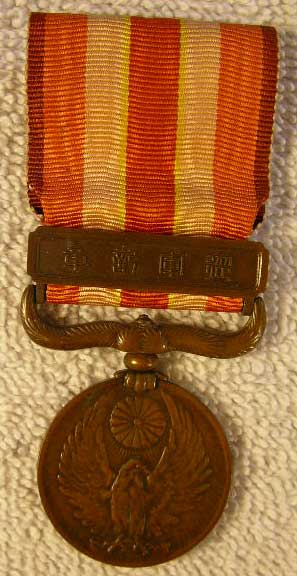
The back of the early medal is quite different
from the later one. For obvious reasons this early one is often called the
“helmet medal”.
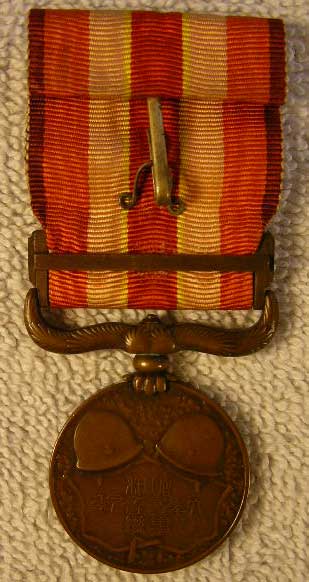
Here you can see that this bird is not the same
one as on the later medal. This one is supposed to be the golden kite (kin-shi) that helped the mythical first
emperor, Jimmu, to victory by bringing him a message from the gods to attack
from the east at dawn, when his enemies would be blinded by the sun. Note the
hooked beak, which is obviously that of a bird of prey. The medal is 30mm
(1-3/16”) in diameter. The ribbon is the standard 37mm used on Japanese service
medals.

Closer in you can see that the left
helmet has an anchor, signifying the Navy, while the right one has a star, signifying
the Army. The inscription reads from right to left in three lines: sho-wa-roku-nen-nai-shi-kyu-nen-ji-hen,
or “Showa 6-9 incident”. Showa 6 to 9 corresponds to 1931 to 1934 by the
Western calendar.

Here is the medal in its box.

The box lid says: sho-wa-roku-nen-nai-shi-kyu-nen-ji-hen-ju-gun-ki-sho,
or “Showa 6-9 incident war medal”. Note that this box is pressed cardboard
rather than the balsa wood used for earlier medals like those for World War
One. The box is 110mm X 60mm X 21mm (4-5/16” X 2-3/8” X 7/8”).

The certificate for this medal measures
418mm X 323mm (16-7/16” by 12-23/32”). The right side has the recipient and the
date of the award. The left side has the formalities from the Board of
Decorations. It has two watermarks that
are shown below, but nothing is printed or stamped on the back. It is made from
a thicker, stiffer material than the World War One medal certificates, almost
like thin cardboard.
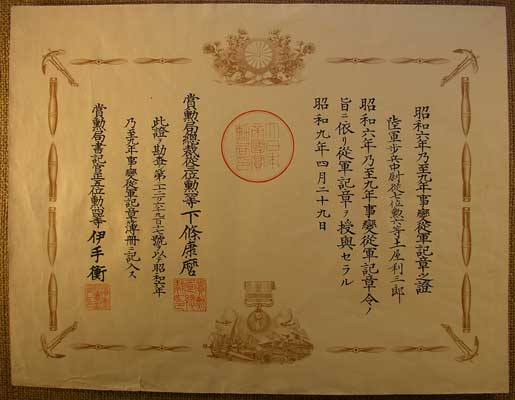
This close-up of the right side has
the most important information.
First
column (far right): Sho-wa-roku-nen-nai-shi-kyu-nen-ji-hen-ju-gun-ki-sho-no-sho
Second
column from right: Riku-gun-ho-hei-chu-i-ju-nana-i-kun-roku-to-tsuchi-ya-ri-sabu-ro
Third
column from right: Sho-wa-roku-nen-nai-shi-kyu-nen-ji-hen-ju-gun-ki-sho-rei-no
Fourth
column from right: mune-ni-yori-ju-gun-ki-sho-o-ju-yo-seraru
Last
column (on left): Sho-wa-kyu-nen-shi-gatsu-ni-ju-kyu-nichi
This translates roughly as:
“Certificate for Medal for Military Service During the
Showa 6 to 9 [1931-1934] Incident. Army Infantry First Lieutenant Risaburo Tsuchiya [surname is
Tsuchiya], Junior Seventh Rank and holder of the Sixth Order of Merit, is
awarded the Medal for Military Service in accordance with the regulations
regarding the Medal for Military Service During the
Showa 6 to 9 Incident. Dated April 29, Showa 9 [1934].” I bought this
certificate at an antique market in
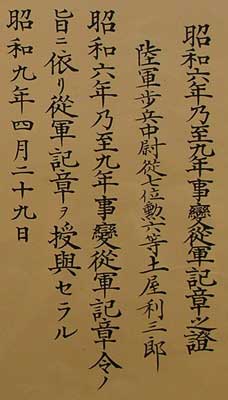
This close-up of the left side has
the formalities from the Board of Decorations (shokunkyoku).
First
column on far right: Sho-kun-kyoku-so-sai-ju-san-i-kun-it-to-shimo-jo-yasu-maro
Second
column from right: kono-sho-o-kan-sa-shi-dai-ni-ju-ni-man-roku-sen-kyu-hyaku-ju-nana-go-o-motte-sho-wa-roku-nen
Third
column from right: nai-shi-kyu-nen-ji-hen-ju-gun-ki-sho-bo-satsu-ni-ki-nyu-su
Last
column (on the left): sho-kun-kyoku-sho-ki-kan-sho-go-i-kun-yon-to-i-de-hitoshi
[last character could also be pronounced Mamoru]
With family names underlined, this
translates roughly as: “President of the Board of Decorations Yasumaro Shimojo,
Junior Third Rank, and Holder of the First Order of Merit. Having checked this
certificate we have entered it in the Register of Medals for Military Service During the Showa 6 to 9 Incident as number 226917. Secretary
of the Board of Decorations Hitoshi Ide, Fifth Rank, Holder
of the Fourth Order of Merit” The red stamps at the ends of columns with names
and titles repeat the titles of the individuals whose names appear here, i.e.
President of the Board of Decorations or Secretary of the Board of Decorations,
as the case may be. I have gone out a bit on a limb here with my translation.
Accompanying the names of senior figures in pre-war

Here is a close-up of the artwork in the
centre-top of the certificate. The chrysanthemum in the centre is, of course,
the symbol of the Imperial Family.
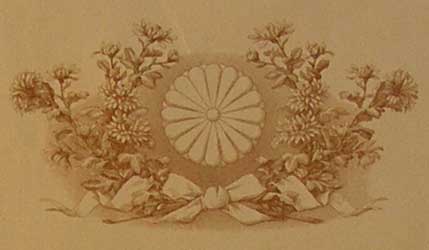
The red seal in the centre says Dai nippon teikoku shokunkyoku-in, or “seal of the Board of
Decorations of the Empire of Greater Japan”.

Here is the artwork in the
centre-bottom. If you compare this to the World War One and earlier service
medals, you will note the addition of a tank, truck and two airplanes. The
light machine gun in the lower right appears to be a Type 11. You can see
photos of a real Type 11 in the section on Japanese Machine Guns. Note that the
sword leaning up against the butt of the machine gun is an older, Western-style
sword known as a kyu-gunto (old-style
military sword). It was replaced starting in 1934 with the more familiar
Japanese sword similar in style to the samurai sword, but some officers kept
carrying their older swords.

There is a watermark of
a chrysanthemum in the upper right. This photo appears very orange because I
had to put an incandescent light right behind this spot to get the image to be
bright enough to get a shutter speed fast enough for a sharp, clear shot.
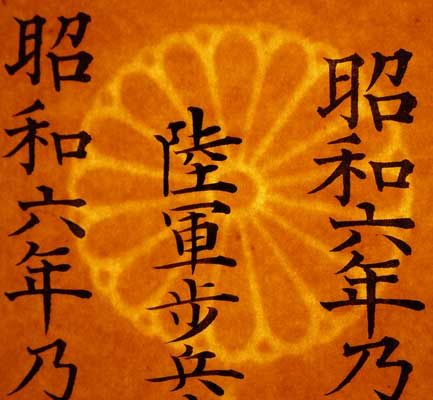
There is also a smaller watermark in
the lower left. It represents a sakura
(cherry) blossom with the character in
(pronounced een) inside it. That character is the first one in the word insatsu (printing). I suspect it is the
watermark of the government printing office. The image is orange for the same reason
as the photo of the other watermark.
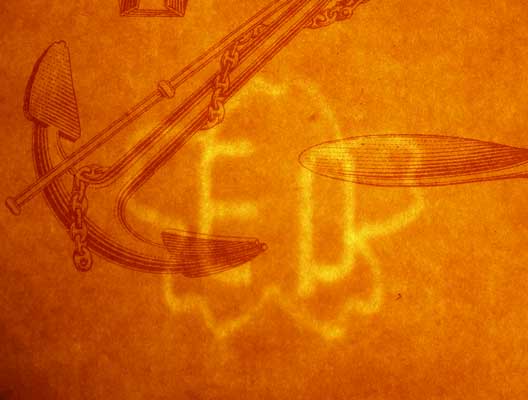
If you are interested in reading
more about the background of the Japanese in Manchuria is The Making of Japanese
To return to the base page on
Medals, please click here: Nambu World: Japanese Medals
To return to “Other Japanese
Militaria”, please click here: Nambu World: Other Japanese
Militaria
To return to the home page, please
click here: Nambu
World: Teri’s WWII Japanese Handgun Website
Last updated: August 15, 2006. All contents are copyright Teri unless otherwise
specified and may not be used elsewhere in any form without prior permission.